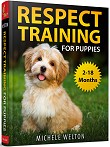Housebreaking (Potty Training) For Puppies and Adult Dogs
By Michele Welton, Dog Trainer, Breed Selection Consultant, Author of 15 Dog Books

When you're frustrated with your dog about potty training problems, he can tell!
If owners could choose only one skill they wanted their dog to have, HOUSEBROKEN would probably be the winner.
Housebreaking problems are a chief complaint of dog owners who contact me for behavioral consulting.
Who is happy with a dog who's peeing or pooping in the house?
This is what I tell dog owners who are looking for housebreaking advice:
There are two rules for housetraining. Just two, but you have to get them both right. And I mean 100% right, not 50% right. Otherwise you're going to end up with a dog who is 50% housebroken, and who wants that?
So here they are....my two Golden Rules for housebreaking:
Rule #1. Confinement – so your pup can't go to the bathroom in the wrong place.
Confinement means that until your pup is completely housebroken, he is NEVER allowed to walk freely around the house.
You can confine your pup in a crate, a pen, or by using baby gates to section off a small space (mud room, laundry room, kitchen).
He needs to stay in this space every minute of every hour of every day – unless you're sitting with him, playing with him, walking him, feeding him, grooming him, teaching him, or otherwise interacting with him.
This is hard for most people, I know. It's so tempting to let the puppy loose to run and play while you watch TV or fix dinner.
But if you let a non-housebroken puppy (or adult dog) loose in the house when you're doing something else, even if you promise yourself that you'll "watch" him, he can go to the bathroom MUCH more quickly than you can stop him – and the bad habit is begun.
Rule #2. Regular or constant access to the alt place to go.
 You have three options here:
You have three options here:
1) Take your pup outside every 2-3 hours.
2) Or install a doggy door so he can take himself outside into an enclosed "potty yard." (Don't do this if you're not home, else he might stay outside and drive your neighbors crazy with his barking.)
3) Or provide an indoor bathroom such as newspapers or (for very small dogs) a litter box.
Your dog must have SOMEWHERE accessible so he can "go" when he needs to go. Otherwise he will "go" wherever he happens to be at the time.... what else can he do, right? It's not his fault.
Housebreaking success or failure is up to you
- If you arrange things so that the only place your pup has a chance to "go" is where you want him to go, that's the habit he will develop.
- But if you give him too much freedom in the house, or if you don't give him quick access to a bathroom when he needs to go, that's the habit he will develop.
Now, I've made it seem quick and easy to housebreak your pup. Just two simple rules. One, two, and done!
Except for the details.
- For example, when you take your pup outside to go to the bathroom, do you keep him on a leash or let him loose? What should you do if he just wants to play and refuses to "go"? Do puppies eliminate more readily if you take them for a walk?
- How do you teach a pup to use a doggy door to take himself out?
- What is the best kind of litter box (and litter) for small dogs?
- What if your pup keeps soiling his crate or pen?
- How long can a pup reasonably be expected to "hold it" during the day and during the night?
- When your dog is beginning to catch on to the idea of housebreaking, when do you relax your strict confinement rules? And HOW do you relax them? You can't go from complete confinement to complete freedom. Transitions matter – a lot.
I can guide you through the transitions, as well as show you different techniques for crate training, newspaper training, litter box training, and doggy door training. There are some right ways – and lots of wrong ways – to teach these housebreaking methods.
I can guide you with my complete training program, which is available free on my website. Scroll down to read it!
My best-selling books – now available FREE on my website
 Respect Training For Puppies: 30 seconds to a calm, polite, well-behaved puppy is for puppies 2 to 18 months old. Your puppy will learn the 21 skills that all family dogs need to know. Click here to read for free.
Respect Training For Puppies: 30 seconds to a calm, polite, well-behaved puppy is for puppies 2 to 18 months old. Your puppy will learn the 21 skills that all family dogs need to know. Click here to read for free. Teach Your Dog 100 English Words is a unique Vocabulary and Respect Training Program that will teach your adult dog to listen to you and do what you say. Click here to read for free.
Teach Your Dog 100 English Words is a unique Vocabulary and Respect Training Program that will teach your adult dog to listen to you and do what you say. Click here to read for free. 11 Things You Must Do Right To Keep Your Dog Healthy and Happy helps your dog live a longer, healthier life. Get my honest advice about all 11 Things before you bring home your new puppy, because some mistakes with early health care cannot be undone. Click here to read for free.
11 Things You Must Do Right To Keep Your Dog Healthy and Happy helps your dog live a longer, healthier life. Get my honest advice about all 11 Things before you bring home your new puppy, because some mistakes with early health care cannot be undone. Click here to read for free.
